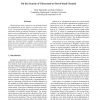Free Online Productivity Tools
i2Speak
i2Symbol
i2OCR
iTex2Img
iWeb2Print
iWeb2Shot
i2Type
iPdf2Split
iPdf2Merge
i2Bopomofo
i2Arabic
i2Style
i2Image
i2PDF
iLatex2Rtf
Sci2ools
IPPS
2007
IEEE
2007
IEEE
On the Security of Ultrasound as Out-of-band Channel
Ultrasound has been proposed as out-of-band channel for authentication of peer devices in wireless ad hoc networks. Ultrasound can implicitly contribute to secure communication based on inherent limitations in signal propagation, and can additionally be used explicitly by peers to measure and verify their relative positions. In this paper we analyse potential attacks on an ultrasonic communication channel and peer-to-peer ultrasonic sensing, and investigate how potential attacks translate to application-level threats for peers seeking to establish a secure wireless link. Based on our analysis we propose a novel method for authentic communication of short messages over an ultrasonic channel.
Distributed And Parallel Computing | IPPS 2007 | Potential Attacks | Ultrasonic Communication Channel | Wireless Ad Hoc Networks |
| Added | 03 Jun 2010 |
| Updated | 03 Jun 2010 |
| Type | Conference |
| Year | 2007 |
| Where | IPPS |
| Authors | Rene Mayrhofer, Hans Gellersen |
Comments (0)

